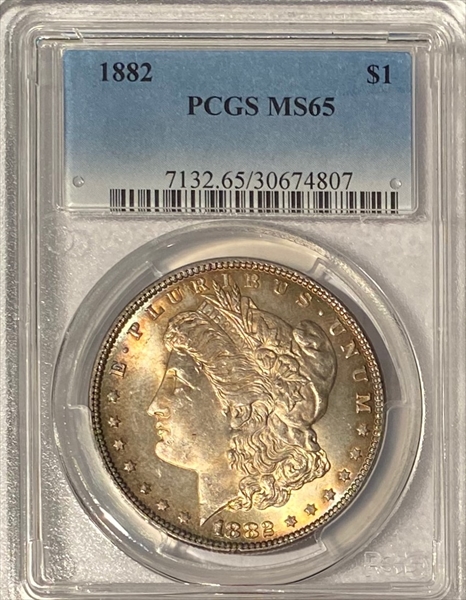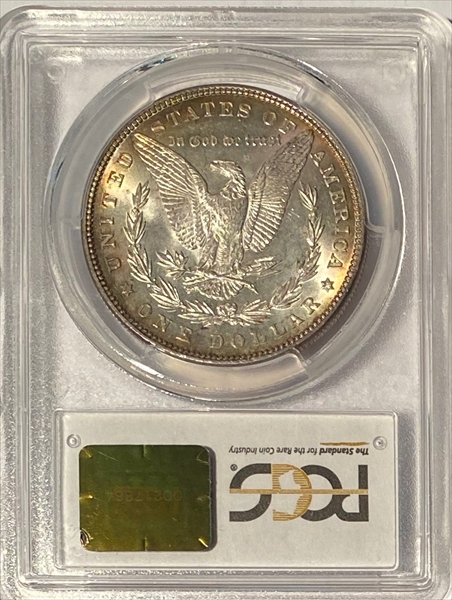1882 $1 MS65 认证号30674807, PCGS号7132
拥有者评论
Upgrade from MS64
专家评论
Q. David Bowers
The following narrative, with minor editing, is from my "Silver Dollars & Trade Dollars of the United States: A Complete Encyclopedia" (Wolfeboro, NH: Bowers and Merena Galleries, Inc., 1993)Numismatic Information
Hoard coins: Mint State coins have been common for many years, even before the Treasury release of 1962-1964. Many of this date were stored at the Philadelphia Mint and also by the Federal Reserve System. However, by now it is probably the case that most original mint-sealed bags have been broken open and dispersed.
Circulated grades: The 1882 dollar is very common in worn grades, and relatively little numismatic attention is paid to it. Many were melted in the 1970s during the run-up in silver bullion prices. At the time there was virtually no numismatic demand for a worn 1882 dollar.
Mint State grades: Most Mint State coins are in the range of MS-60 to MS-63. Such coins are apt to show numerous bagmarks from long-time storage and moving in bags.
At the MS-64 level, 30,000 or more exist. Only in MS-65 or better grade does the circulation strike 1882 Morgan dollar become scarce; only about 3,500 to 5,000 are estimated to remain.
The typical 1882 dollar is apt to have an average to above average strike, but quality varies; weakly defined specimens also exist. Once again, this is an issue which the buyer should cherrypick for quality.
Prooflike coins: Semi-prooflike coins are found with some frequency on the market, but true prooflike coins are scarce. Most of the latter have little contrast between the devices and the fields. Probably, 2,500 or more remain, mostly in lower grades. When found, prooflike coins are apt to be heavily bagmarked. DMPL coins are slightly less often found. Only a few in each category are in grades of MS-65 or higher.
Varieties
Circulation strikes:
1. Normal date: Breen-5565. Most of the 56 obverse and 58 reverse circulation strike dies were probably used. Filled 2 (VAM-IB) is much less common than clear 2; open 2 (knob and tail free of middle stroke) is much less common than closed 2 (knob and tail touch middle stroke). At least 10 obverses show partly or wholly repunched dates. 19 circulation strike varieties are described by VAM.
Dies prepared: Obverse: 56; Reverse: 58
Circulation strike mintage: 11,100,000
Estimated quantity melted: Unknown, but millions under the 1918 Pittman Act and later, including during the run-up in silver prices in the late 1970s.
Availability of prooflike coins: True prooflike coins are elusive, although semi-prooflike specimens are numerous. DMPL specimens are slightly scarcer than PL examples.
Characteristics of striking: Most seen are fairly well struck. However, flatly struck pieces exist as do average strikes.
Known hoards of Mint State coins: Large numbers were held by the Treasury and released in the 1950s and in 1962-1964 as well as in prior years.
Commentary
1882 silver dollars are very common in circulated grades as well as lower Mint State levels, but in MS- 65 they are scarce.
Silver Dollar News Items
The Annual Report of the Director of the Mint, 1882, included several references to silver dollars and the various mints, among which were these items:
The average price paid during the year for silver bullion was $1.0215 per standard ounce (.900 fine). In New York the selling price of silver during the year was $1.13799 per fine ounce (.999 fine) or $1.02419 per standard ounce.
As of June 30, 1882 the following silver dollars were on hand at the various mints and the following numbers had been distributed during the last fiscal year: Philadelphia: In mint, 4,248,069; distributed, 8,053,808; San Francisco, in mint, 25,114,407; distributed, 1,826,728; Carson, in mint, 1,260,901; distributed, 563,090; New Orleans, in mint,4,742,295, distributed, 5,303,837.
Silver Coins in Circulation
The following is adapted and quoted from Neil Carothers, Fractional Money, pp. 268-269:
On July 1, 1882 there was about $28 million worth of subsidiary coins in Treasury vaults and about $50 million worth in circulation, the latter being approximately equal to the total of new coins produced and issued since 1875. The Treasury holdings are believed to have consisted almost entirely of coins that had "disappeared" in 1862 and came back into the United States in the late 1870s. These could have included Liberty Seated silver dollars, but records are silent on this point. The maximum was reached in 1885 when $30 million worth of coins accumulated in Treasury reserves.
It was estimated that $40 million worth of subsidiary silver coins had disappeared in the summer of 1862, and about $30 million worth had returned from Latin America in the late 1870s only to be stored in government vaults.
Carothers wrote: "Millions of these coins were so badly worn that the public would not want them. They needed to be melted, but recoinage meant a definite loss. Congress did not consider the matter until 1882, when it gave an appropriation of $25,000-which permitted a small fraction of the amount to be recoined. Secretary McCullough in his annual report for 1884 made an urgent plea for a sum sufficient to cover the cost of a general recoinage, and in subsequent years many other requests were made. Congress did not face the situation until 1891....
"For nearly a generation this great hoard lay in the Treasury. When applicants for new coins appeared at the Mint they were told to go to the Treasury office and buy from the idle stocks." Production of quarter dollars and half dollars remained low throughout the 1880s because of the oversupply.
Secretary of the Treasury John Sherman was so disturbed by the situation that he recommended in his annual report for 1890 that subsidiary coinage be suspended. This mass of earlier-dated coins caused a problem for many years, through about 1900.
In the meantime, unwanted Morgan dollars were produced by the tens of millions and continued to cause storage problems.
PCGS #
7132
设计师
George T. Morgan
边缘
Reeded
直径
38.10 毫米
重量
26.73 克
铸币数量
11100000
金属成分
90% Silver, 10% Copper
更高评级数量
712
评级较低的钱币数量
22342
地区
The United States of America
价格指南
PCGS 数量报告
拍卖 - PCGS 评级的
拍卖 - NGC 评级的
稀有性和存量估计 了解更多
| 所有评级 | 1100000 |
| 60或以上 | 210000 |
| 65或以上 | 5000 |
| 所有评级 | R-1.0 |
| 60或以上 | R-1.8 |
| 65或以上 | R-4.0 |
| 所有评级 | 94 / 117 TIE |
| 60或以上 | 89 / 117 TIE |
| 65或以上 | 73 / 117 TIE |
| 所有评级 | 94 / 117 TIE |
| 60或以上 | 89 / 117 TIE |
| 65或以上 | 73 / 117 TIE |

























